From OOP to POD – Susan Price
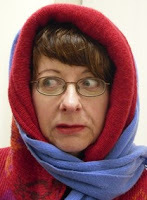 Nowadays when authors' books go OOP (Out Of Print) the books don't necessarily have to vanish. The digital technology of POD (Print on Demand) has made it much easier for authors to reprint their own books. However, all is not quite as easy as might be presumed. Many thanks to this month's guest blogger, Susan Price, who tells us her story of republishing a popular illustrated book and how this lead to further Indie books.
Nowadays when authors' books go OOP (Out Of Print) the books don't necessarily have to vanish. The digital technology of POD (Print on Demand) has made it much easier for authors to reprint their own books. However, all is not quite as easy as might be presumed. Many thanks to this month's guest blogger, Susan Price, who tells us her story of republishing a popular illustrated book and how this lead to further Indie books.With her first book accepted at age 16, Susan's books have since collected many awards, including The Carnegie Medal. Although best known for the young adult genre and her Sterkarm books, Susan has also written books for younger readers.
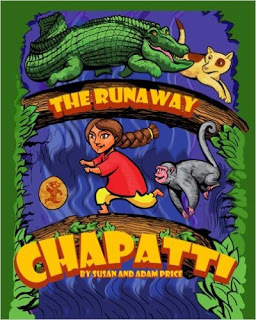 New edition of The Runaway Chapatti,
New edition of The Runaway Chapatti, by Susan and Adam Price
Some years ago now, I worked with Cambridge University Press’ education branch to make early reader texts. It wasn’t just a matter of telling a story – certain sounds had to be emphasised, and some picked out in large speech bubbles, to encourage recognition and memory.
CUP asked me to retell The Runaway Chapatti and it was great fun. It was published as a very large book – nearly as big as the small children who were to read it — and with wonderful, bright illustrations.
It proved to be very popular but, as is the way of these things, CUP let it go out of print.
Ever since then I’ve had regular emails from parents and teachers, asking where they can find copies — that is, copies costing less than the £89 being charged on Amazon market place.
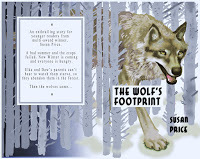 I was used to this. Another book of mine,
The Wolf’s Footprint
, was popular in primary schools and after it went out of print there was a small but constant stream of emails from teachers and parents, asking me where they could buy copies.
I was used to this. Another book of mine,
The Wolf’s Footprint
, was popular in primary schools and after it went out of print there was a small but constant stream of emails from teachers and parents, asking me where they could buy copies.So I decided to take the book from OOP to POD – print on demand.
My rights in the book had reverted to me — but that only meant the words. I couldn’t simply take the book and bung it up on Amazon as a self-published book, because the lay-out belonged to its original publisher. The margin widths, the font they’d chosen, the whole look of the book had been bought and paid for by them.
And, of course, the illustrations were the copyright of the artist.
Some self-published writers have asked their publisher to grant them the right to use the old cover — which is often the property of the publisher rather than the artist, having been bought outright. In some cases, the publisher grants permission, in others they don’t. Some writers also negotiate with the artists, and use the same illustrations.
I didn’t want to go that route. I didn’t want to spend weeks waiting for a reply from a publisher, and then be told, ‘No.’
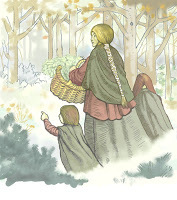 The Wolf's Footprint,
The Wolf's Footprint, illustration by Andrew PrinceAnd if I was going to be an Indie, I wanted my books to look Indie, and not exactly the same as the previous edition.
Nor was finding artists going to a problem. I have two brothers, Andrew and Adam. Both are talented artists.
I asked my brother, Andrew Price, to illustrate The Wolf’s Footprint and it’s now available again, as an e-book and paperback. It sells steadily, here and in America, in both formats.
So, I thought, why not republish The Runaway Chapatti?
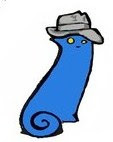 Blott, Adam PriceAndrew was busy, so I asked Adam, if he would like to do the new illustrations. Adam had already done a series of Blott cartoons for my website, so I knew his style: the compact chunkiness, the lively sense of movement, the characterisation. Yes, I’m biased, but I love his illustrations.
Blott, Adam PriceAndrew was busy, so I asked Adam, if he would like to do the new illustrations. Adam had already done a series of Blott cartoons for my website, so I knew his style: the compact chunkiness, the lively sense of movement, the characterisation. Yes, I’m biased, but I love his illustrations.Adam was enthusiastic, though he made it clear that he would be doing it his way, and not copying the original. I wouldn’t want anything else. I gave him the text and let him get on with it.
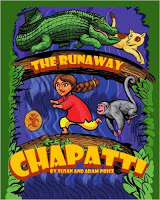 Some months later he came to my house with several large boards, glowing with colour, which he stood around the room, leaning against chairs. I was glad I’d asked him to do it.
Some months later he came to my house with several large boards, glowing with colour, which he stood around the room, leaning against chairs. I was glad I’d asked him to do it.The text of the book hasn’t changed much, and we hope that people will find it as entertaining as its original. (Find the new The Runaway Chapatti here.)
We would have loved to make our book as large as the original, but we used Amazon’s CreateSpace. The largest size which Amazon produces is 11 inches by 8 (roughly 28 cms by 20cms. Amazon deal in inches.) We may look into publishing a larger version in the future.
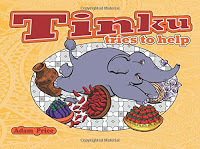 Tinku tries to help by Adam PriceUsing what he learned from our chapatti adventure, Adam went on to write and illustrate his own picture book – with a little influence from Pratibha, his wife, who loves elephants. Drawing on his experience of visiting India with Patti, for family weddings, Adam wrote Tinku Tries To Help, the tale of a baby elephant desperate to help with preparations for the Maharajah’s wedding day. (Mysteriously, this book, only published last month, is already being offered for £24, and even £210, by other sellers on Amazon when Adam is only asking £5.99. What are this other sellers doing? — Adding platinum dust?
Tinku tries to help by Adam PriceUsing what he learned from our chapatti adventure, Adam went on to write and illustrate his own picture book – with a little influence from Pratibha, his wife, who loves elephants. Drawing on his experience of visiting India with Patti, for family weddings, Adam wrote Tinku Tries To Help, the tale of a baby elephant desperate to help with preparations for the Maharajah’s wedding day. (Mysteriously, this book, only published last month, is already being offered for £24, and even £210, by other sellers on Amazon when Adam is only asking £5.99. What are this other sellers doing? — Adding platinum dust?Tinku’s story begins:
In the shadow of the mystical mountains,
Deep in the tiger-haunted jungle,
Stood a city of flowers and fountains,
That was home to the marvelous Mogul.
In his palace of marble and jade,
With domes and spires of golden glory,
Tinku the elephant lived and played,
Now listen as I tell her story.
Tinku meets failure after failure as she tries to find a way to help, but when her mother discovers her weeping over all the set-backs, she is told:
So you didn’t get it right first time,
Don’t give up or lose heart,
You see, it’s not success or pride or fame,
But trying that’s the important part.
A fabulous future is what I see,
For you, oh my gifted girl.
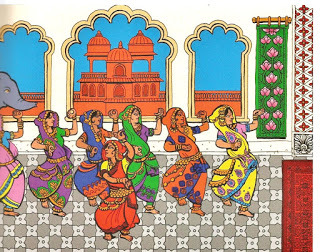
But my daughter is what you’ll always be,
And to me that is worth the world.
So if you dance or guard the king,
Sit still and quiet, or play music loud,
Know you are my everything,
And I am so very proud.
On the very last page, we are told:
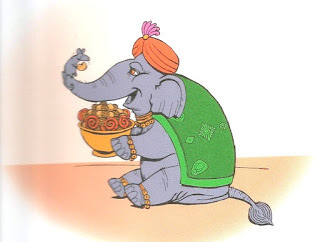 …There is only one more thing to say,
…There is only one more thing to say,About me, (Tinku’s) good and faithful friend.
For you may ask me how I learned this rhyme,
What was said, by whom and where,
I watched it happen at the time.
On every page you’ll find me there! — A little mouse!
And this sends us back to the very first page, to hunt for the mouse, who is hidden somewhere in the detailed illustrations. I have to say, I wish I’d written this, and I’m very proud of my brother.
Then my brother Andrew suggested we should work together on The Billy Goats Gruff — he knows I’ve always been a sucker for the story, a masterpiece of narrative tension.
Contributors to this blog won’t need telling how much hard work goes into writing and illustrating a picture book — but it surprised me a little.
Don’t think that I dismiss ‘writing children’s books’ as easy — very far from it!
I know how much work and discussion goes into these ‘little books,’ how much knowledge of the teaching of reading and the psychology of learning. Quite apart from the skill needed to simply tell a story!
But, before this, I was involved only in providing the text. I handed that over to a publisher, and saw nothing of the artist’s work.
But I’ve worked closely with Andrew on our Billy Goats. The story-boarding, discussions, text-changes and the re-working of illustrations have taken months. It’s been fascinating, exciting, frustrating, exhausting — and enormous fun. But definitely work. Detailed work, demanding concentration and lots of thought.
I respected the writers and illustrators of picture books before — but my admiration has certainly grown!
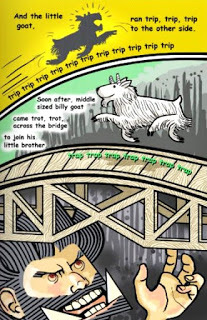 We’re nearing completion of the Three Billy Goats Gruff. Andrew wants to use a comic-book style of telling, so there are many speech-bubbles and also ‘sound-effects.’ The ‘trip-trip’, ‘trot-trot’ and ‘tramp-tramp’ of the goats’ hooves will be spelt out — which helps with recognition of the ‘tr’ sound. Here’s a taster.
We’re nearing completion of the Three Billy Goats Gruff. Andrew wants to use a comic-book style of telling, so there are many speech-bubbles and also ‘sound-effects.’ The ‘trip-trip’, ‘trot-trot’ and ‘tramp-tramp’ of the goats’ hooves will be spelt out — which helps with recognition of the ‘tr’ sound. Here’s a taster.
Oh, and what the heck — I may as well end with a blatant plug. My brothers also produce greetings cards and Christmas cards, which can be seen here, in their Etsy shop.
~ Susan Price
So, republishing The Runaway Chapatti lead to Tinku, which lead to The Three Billy Goats Gruff, and these indie publishing ventures have involved The Three Prices (Susan, Andrew and Adam Price).
Published on November 16, 2015 00:06
No comments have been added yet.



